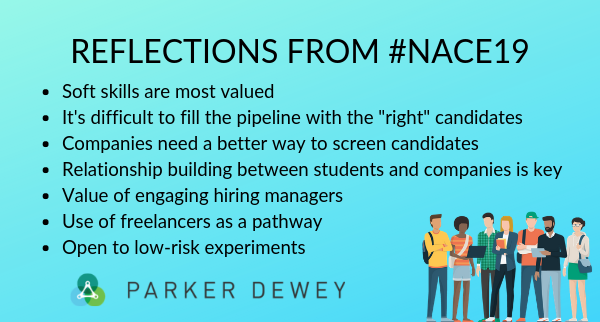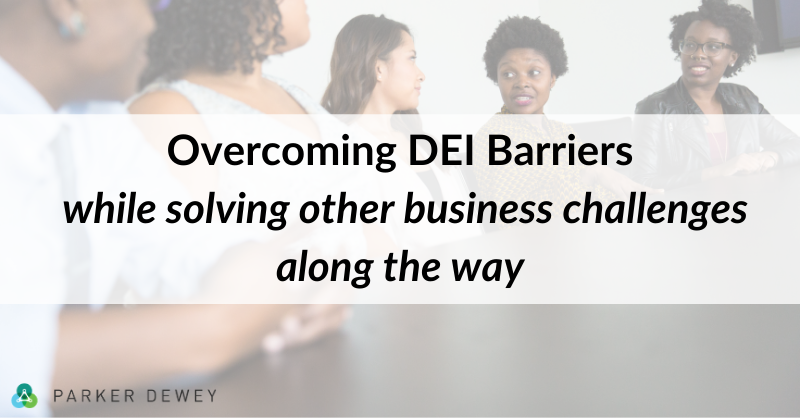
Reflections from NACE#19
I always leave the NACE conference feeling so inspired as there are literally thousands of professionals from companies, colleges, and foundations who are 100% focused on improving college-to-career transitions, something we are passionate about at Parker Dewey. As I reflect on all of the sessions and conversations from #NACE19 last week, a few themes emerged.
Soft skills are most valued
While there were a few sessions and discussions focused on the importance of coding skills and the so-called “skills gap” of candidates, the vast majority of employers highlighted the importance of Core Skills such as communication, problem solving, adaptability, and grit. Without exception, employers expressed a strong willingness to train new employees in the functional skills for entry-level roles, such as Fidelity’s new hire program where Catalina Hernandez shared how they bring in college professors and other subject matter experts to help on-board. While getting hiring manager buy-in can be difficult as many are used to recruiting from certain majors, Brittany Sever highlighted Asurion's efforts to focus on the immediate staffing needs of these same hiring managers to do so (more to come on this point).
It’s difficult to fill the pipeline with the “right” candidates
Even with Strada Foundation and Burning Glass reporting that under- and unemployment of recent college grads is over 40%, companies still feel pressure filling their pipeline with the right applicants. To be clear, “right” does not mean candidates with certain GPAs or majors. As Ryan Emerson highlighted, there is “significant value to providing equitable opportunities for students who may not otherwise have pathways into companies such as E&Y.” And while companies recognize the value of diversity, unfortunately many diversity and inclusion efforts are little more than “checking the box” or have unintended consequences. To that, Michele Militante highlighted that while IBM has a comprehensive campus recruiting effort, it sees massive value looking beyond the traditional focus schools, especially those without the same handful of tech companies.
In addition, for many organizations, students may not be aware of certain roles at their companies or have preconceived notions about their brands. As Dylan Schweitzer shared, very few college students plan to work for Enterprise upon graduation, so providing awareness of the company’s development program and benefits of the role is vital. This is neither surprising nor unique, as NACE research highlights that building brand on campus is vital for campus recruiters.
Companies need a better way to screen candidates
This was probably one of the most interesting topics of the conference, especially given the mix of vendors, companies, and universities discussing the challenges they faced, and techniques used to address them. There was of course the usual mix of video interviews and predictive hiring (AI, assessment, etc.); however, not surprising employers shared that these tools did not eliminate work (“we still have to watch the video”) or had potential unintended consequences such as hindering diversity and inclusion efforts (I lost count of the number of references to Amazon). In fact, one company highlighted that it didn’t trust these tools to filter candidates, so it was relying on a vendor to make the selections on its behalf. Not only was it surprising that this organization thought a third party could make a better decision, this third party was (wait for it) using these same tools to do so!
However, the pain of selecting candidates to interview is real in terms of time, cost, and effectiveness. To that, Maura Quinn shared a really creative way that Liberty Mutual is empowering hiring managers to help in the process. Instead of asking them to review resumes and conduct phone interviews, hiring managers “who have staffing needs as well” can engage college students on projects, and share feedback to HR on if these Career Launchers would be strong candidates for internships and / or full-time roles at the company. And given that their “interns outperform any other source of hiring,” this provides yet another way for Liberty Mutual and candidates to mutually assess fit up front.
These screening challenges also tie closely to the aforementioned value companies place on soft skills, especially given the difficulty of assessing them. While a major may convey if a college student has specific technical skills, JP Morgan is “more interested in hiring people who will pick up the phone and can have a thoughtful conversation,” per Seldric Blocker. Although companies can teach functional skills for new and existing hires, it’s much more difficult to develop skills such as adaptability, analytical thinking, and communication; therefore, finding Career Launchers who possess these competencies is vital, especially since they are not easy to assess from a resume or interview at this level.
Relationship building between students and companies is key
The value of real relationships was something that came up frequently, as there were so many value propositions. Whether it was gaining early access to potential candidates, introducing or enhancing a corporate brand, or driving conversion through ongoing engagement, companies recognize the benefits. One interesting use case was Intuit’s, as Dawn Carter shared strategies for staying engaged with candidates who were either declined by Intuit or did not accept a position. However, as Dawn shared, these efforts need to be genuine – they can’t be just automated emails and text messages. Instead, provide opportunities for students to learn more about your company (another info session or “just want to check in” phone call doesn’t cut it), and for you to learn about a student, especially if there were specific areas you were not confident about from the interview process.
Value of engaging hiring managers
Not surprisingly, the best campus recruiting process are collaborative efforts between HR and hiring managers, a common trait shared by companies that already have strong intern programs such as CIGNA. As Allison Eastwood and Jackie Reis shared, effective communication and expectation setting with the managers is vital. Specifically, this process should include defining responsibilities for the interns upfront, ensuring the actual projects align to these expectations during the summer, and evaluating the outcomes at the conclusion of the summer.
But engaging hiring managers goes beyond existing internship and new hire efforts. Kellye O’Connor shared how Asurion is using more flexible, project-based engagements as part of its campus recruiting process. Not only are hiring managers already comfortable with this model, but they provide a great way to build relationships with rising juniors and other underclassmen. And given that “hiring managers ask for more interns even on day-one of the internship program,” Micro-Internships provide a great opportunity to offer these hiring manager an extra resource while leveraging them to provide feedback on prospective candidates at the beginning of the campus recruiting process.
Use of freelancers as a pathway
To the last point, more organizations are recognizing the value of freelancers not as a replacement for interns and new hires, but as a pathway to identify, assess, and hire Career Launchers. Matt Mottola offered a unique perspective not only given his current role at Microsoft, but as someone who “was often filtered out by employers based upon [his] school.” By working on a series of freelance engagements while in college, Matt was able to demonstrate his skills to employers (including many who might not otherwise consider him), and help determine the right full-time role to accept upon graduation.
And, as Adam Hecktman shared, project-based recruiting aligns with many of Microsoft’s corporate efforts as well, providing an effective way of looking beyond focus schools and democratizing the hiring process. Unlike so many of the approaches, the impact goes beyond “checking the box” and is cost effective (and low risk) to implement. Beyond the mission-driven benefits, this model is effective as it also provides Microsoft with a competitive advantage in recruiting, diversity, and conversion.
Open to low-risk experiments
What makes so many of these efforts possible is the willingness of HR leaders to experiment. While we still saw some high-stakes / high-commitment approaches, the vast majority of best practices did not rely on ripping out existing systems, trusting a third-party (or technology) to make hiring decisions, or requiring six or seven figure commitments. More importantly they do not require HR professionals to “force” change or create work (actual or perceived) for hiring managers, eliminating a frequent point of friction or pushback.
Instead, many of the best practices leveraged existing resources or behaviors, and simply found new ways to align them to campus recruiting goals. Beyond introducing us to square watermelons (who knew?) KPMG’s Karissa Cornell did a great job highlighting the importance of focusing on the stakeholders’ points of pain, and crafting solutions that solved their pains. Whether it was adding a virtual recruiting tools, leveraging the resource needs and / or use of freelancers by hiring managers, or creatively engaging candidates, all of these strategies are both immediately implementable and require little to no cost (or risk) to pilot.
Although #NACE19 was incredibly comprehensive, I’d really appreciate your perspective. Please share your thoughts about campus recruiting and we’ll publish the results in the coming weeks. Thanks so much.


.png)

-1.png)